Progress towards the emission reduction commitments
The National Emission reduction Commitments Directive sets obligations to reduce national emissions of five pollutants, namely fine particulate matter (PM2.5), nitrogen oxides (NOx), non-methane volatile organic compounds (NMVOCs), ammonia (NH3) and sulphur dioxide (SO2) (EU, 2016). The Directive targets 2020-2029, with more drastic obligations from 2030 onwards.
The analysis presented in this briefing is based on the latest air pollutant emission inventory data[1], [2] (for the year 2021) reported by Member States[3] in 2023. Member States have reported annual emission inventory information since 1990 (2000 in the case of particulate matter).
Policy context
The National Emission reduction Commitments (NEC) Directive sets national commitments to reduce emissions of five pollutants that have significant negative impacts on human health and the environment, namely NOx, NMVOCs, NH3, SO2 and PM2.5. It is one of the legislative instruments supporting the zero pollution ambition to achieve a toxin-free environment, as announced in the European Green Deal. It is particularly critical to delivering on the 2030 targets related to air pollution under the zero pollution action plan (EC, 2021a): to reduce the number of premature deaths caused by air pollution by 55% and to reduce the area of EU ecosystems where air pollution threatens biodiversity by 25%, in both cases compared to 2005 levels. To achieve these targets, it will be vital that EU Member States meet their respective emission reduction commitments set for 2020-2029 and for 2030 onwards under the NEC Directive.
Under the NEC Directive, Member States are obliged to draw up and implement National Air Pollution Control Programmes (NAPCPs), including measures to reduce emissions from relevant sectors to meet national emission reduction commitments and improve air quality.
The European Climate Law aims to cut greenhouse gas emissions, invest in green technologies and protect the natural environment — all with the goal of achieving net zero greenhouse gas emissions (EU, 2021). Ensuring consistency between Member States’ national energy and climate plans (NECP) and their NAPCPs would further reduce air pollutant and greenhouse gas emissions across the energy, industrial, transport and agricultural sectors.
Status of achieving the 2020-2029 emission reduction commitments under the NEC Directive
In 2021, data reported by Member States indicate that 13 Member States met the emission reduction commitments set for the period 2020-2029 for all five main pollutants.
Figure 1 presents the number of Member States meeting their 2020-2029 national emission reduction commitments for the five main pollutants already in 2021. It clearly illustrates that reducing ammonia emissions continues to present a significant challenge to more than one third of Member States, with continued and enhanced efforts needed to lower them.

Note: This information is based on data provided by Member States, not yet checked by the European Commission. The numbers are subject to change in relation to the results of the NEC directive inventory review.
Efforts needed to meet national emission reduction commitments for 2020-2029
Member States need to do more to achieve the national emission reduction commitments set for the period 2020-2029. 13 Member States failing to meet their emission reduction commitments in 2021 for at least one of the five main air pollutants.
Table 1 presents the percentage reductions still required for Member States to reach their 2020-2029 and 2030 emission reduction commitments. The required reductions are calculated as the percentage difference between 2021 reported emissions and the emission reduction commitments for 2020-2029 and for 2030 onwards.
Member States are divided into five groups:
- Member States where current emission levels fulfil their emission reduction commitments;
- Member States that need to reduce emissions by up to 10%;
- Member States that need to reduce emissions by 10% to less than 30%;
- Member States that need to reduce emissions by 30% to less than 50%;
- Member States that need to reduce emissions by 50% or more.
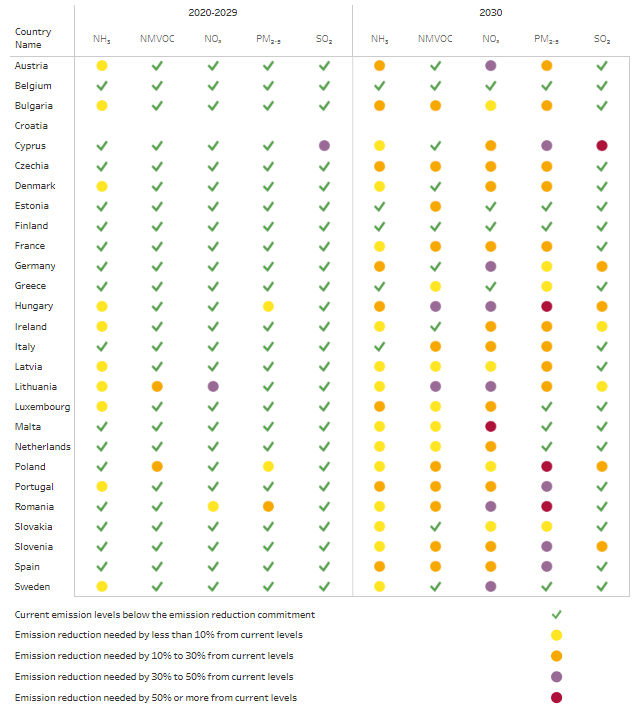
Note: This information is based on data provided by Member States, not yet checked by the European Commission. The numbers are subject to change in relation to the results of the NEC Directive inventory review.
The NEC Directive (Article 5) establishes a process that allows Member States to adjust their emission inventories downwards for compliance checking. This can take place when the failure to comply with the national emission reduction commitments is due to Member States having applied improved emission inventory methods that have been updated in accordance with the latest scientific knowledge that has become available since the reduction commitments were originally set. Ireland submitted a flexibility application in 2023 for an inventory adjustment in relation to NMVOC. This application is taken into account in this current assessment.
10 Member States will have to further reduce NH3 emissions by up to 10% to meet their 2020-2029 national emission reduction commitments. In many Member States, NH3 emissions have decreased only slightly since 2005 or in some cases increased, highlighting the challenge of tackling these emissions. NH3 emissions impact biodiversity and contribute to the formation of secondary [4] PM2.5, the main air pollutant driving premature death in EU Member States. Reducing NH3 emissions is critical to achieving the zero pollution action plan target of reducing by 25% the EU ecosystems where air pollution threatens biodiversity.
Two Member States (Poland and Lithuania) need to reduce their NMVOC emissions to meet their 2020-2029 national emission reduction commitments. They need to reduce emissions by around 13% and 14% respectively.
Two Member States (Lithuania and Romania) need to reduce their NOx emissions to meet their 2020-2029 national emission reduction commitments. They need to reduce emissions by around 32% and 7% respectively.
Three Member States need to reduce their PM2.5 emissions to meet their 2020-2029 national emission reduction commitments. Romania needs to reduce its PM2.5 emissions by around 26% compared to 2021 levels, while Poland and Hungary need to reduce their emissions by around 9% and 7%, respectively. PM2.5 is the air pollutant driving the most significant health problems and premature mortality, making the reduction of PM2.5 emissions critical to achieving the target of reducing the number of premature deaths by 55% by 2030, as set out in the Zero pollution action plan.
All Member States but one fulfilled their 2020-2029 national emission reduction commitments for SO2 Cyprus, where energy supply and use in manufacturing are the principal sources for this pollutant, needs to reduce its SO2 emissions by around 35%.
Progress towards the 2030 emission reduction commitments — the path to achieving a zero pollution Europe
Looking ahead, all Member States except for Belgium and Finland need to reduce emissions for at least one pollutant to fulfil their 2030 commitments. The greatest challenge will be to reduce NH3, NOx and PM2.5 emissions.
Figure 2 presents the number of Member States which, in 2021, had already met their national reduction commitments for 2030 and beyond for the five main pollutants. For the other Member States, it shows the emission reductions, compared to 2021 levels, required to meet 2030 commitments. It should be noted that further measures may also be needed for Member States shown in green below to ensure that emissions do not increase.
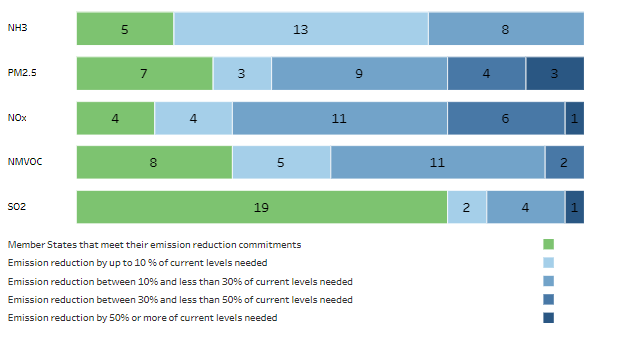
Note: This information is based on data provided by Member States, not yet checked by the European Commission. The numbers are subject to change in relation to the results of the NEC directive inventory review.
Regarding NH3 emissions, five Member States already met their 2030 emission reduction commitments in 2021. In terms of countries needing to do more:
- 13 Member States need reductions under 10%
- 8 need emissions to fall by between 10% and 30%
Regarding PM2.5 emissions, seven Member States met their 2030 emission reduction commitments in 2021. In terms of countries needing to do more:
- 3 Member States, will need to reduce their emissions by more than 50% compared to 2021 levels
- 4 Member States will need to reduce emissions by between 30% and 50%
- 12 Member States will need to reduce their emissions by up to 30%
Regarding NOx emissions, four Member States met their emission reduction commitments for 2030. However, 23 Member States will need to reduce emissions, of which:
- 1 Member State (Malta) will need to reduce them by more than 50%
- 6 Member States will need to reduce them by more than 30%
- 15 Member States will need a reduction of up to 30%
For emissions of NMVOCs, eight Member States met their 2030 emission reduction commitments in 2021. In terms of countries needing reductions:
- 5 Member States need reductions of less than 10%
- 13 Member States need reductions of up to 30%
The picture for SO2 emissions is more positive overall. A challenge remains for Cyprus, where emission reductions of more than 50% will be needed to reach the 2030 commitment. Germany, Hungary, Poland and Slovenia will also need to reduce their emissions by up to 30%, while Ireland and Lithuania need to reduce their emissions by up to 10%.
Main sources of air pollutants in 2021
The economic sectors responsible for emissions to the air vary by pollutant. This section of the briefing presents information on the sources of these air pollutants, addressing a broader range of air pollutants than those covered by the NEC Directive.
Figure 3 presents the sectors and activities that contributed to the majority of main air pollutant emissions in the EU Member States in 2021.
The primary source of particulate matter, including PM2.5, PM10 and black carbon (BC), was energy consumption in the residential, commercial and institutional sector. It was responsible for 62%, 44% and 42% of reported emissions, respectively. Changes in the energy sector will be crucial for meeting the emission reduction commitments for PM2.5, as the burning of solid biomass and fossil fuels for residential heating still contributes significantly to emissions in some Member States. Actions to reduce emissions include improving insulation and upgrading heating systems, installing low-emission boilers or switching fuel types. Significant emissions of particulate matter also result from the manufacturing and extractive industry sector and from road transport, including from internal combustion engines and from tyre and brake wear in vehicles.
The agriculture sector was the principal source of NH3, responsible for 93% of emissions. The European Commission’s Third Clean Air Outlook concluded that the measures currently in place are not enough to reduce NH3 emissions to the extent needed to meet the emission reduction commitments, and that further measures need to be put in place in several Member States. As such, Member States should include more measures applicable to the agriculture sector in their updated national air pollution control programmes (NAPCPs), such as good practice for housing and feeding livestock, storing manure and spreading it on land, and sustainable fertiliser use.
The road transport sector was the main source of reported NOx emissions, responsible for 41%, followed by the energy supply sector at 17%. The manufacturing and extractive industry sector and the residential, commercial and institutional sector were each responsible for 13%. In 2021, the COVID-19 lockdowns led to significant declines in road traffic. This may have helped all but two Member States achieve their NOx emission reduction commitments for 2021.
The manufacturing and extractive industry sector is the single main source of NMVOC emissions, responsible for 42% of the total, followed by the agriculture sector responsible for 21%. The residential, commercial and institutional sector was the third-largest contributor at 18%.
Energy supply was the principal source of SO2 emissions at 65%, with the manufacturing and extractive industry sector being the second-largest contributor at 21%.
The residential, commercial and institutional sector was the main source of CO emissions followed by the road transport sector, responsible for 48% and 24% respectively.
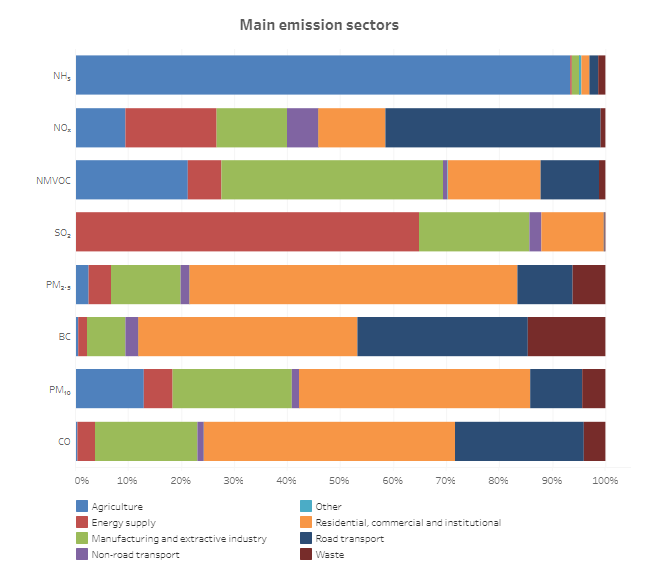
Note: This information is based on data provided by Member States, not yet checked by the European Commission. The numbers are subject to change in relation to the results of the NEC directive inventory review.
Figure 4 shows what the main source sectors contributed to EU Member States’ emissions of heavy metals and benzo(a)pyrene (BaP) in 2021.
- The manufacturing and extractive industry sector was the principal source of all heavy metal emissions, except nickel and mercury. This sector was responsible for 59% of lead, 50% of cadmium and 46% of arsenic emissions.
- The energy supply sector was the main source of nickel and mercury emissions, responsible for 49% and 44% respectively. This was followed be the manufacturing and extractive industry sector, contributing 42% of mercury emissions and 26% of nickel emissions.
- For arsenic, the energy supply sector was the second-largest source of emissions, responsible for 39% of their total. The residential, commercial and institutional sector was the third most important sector, responsible for 8% of arsenic emissions.
- For lead, the second-largest source of emissions was road transport, at 19%, followed by the residential, commercial and institutional sector at 11% of emissions.
- For cadmium, the residential, commercial and institutional sector, and the energy supply sector, were the second and third most important sources. They were responsible for 21% and 20% of total emissions, respectively.
- The residential, commercial and institutional sector was the primary source of benzo(a)pyrene emissions, responsible for 91%.

Note: This information is based on data provided by Member States, not yet checked by the European Commission. The numbers are subject to change in relation to the results of the NEC directive inventory review.
Past trends in air pollutant emissions, 2005-2021
Total pollutant emissions in the EU Member States declined in 2021, maintaining the overall downward trend observed since 2005. Figure 5 shows the trend in total emissions, indexed as a percentage of their value in the reference year 2005 and set against gross domestic product (GDP) as a percentage of the 2005 value.
From 2005 to 2021, PM2.5 and PM10 emissions fell by 28% and 27%. Emissions of SO2 fell significantly between 2005 to 2021 with a decrease of 80%. Major reductions were also seen for nitrogen oxides (47%), black carbon (40%), CO (37%) and NMVOCs (29%).
Notably, NH3 emissions reduced the least – by only 13% over this period.
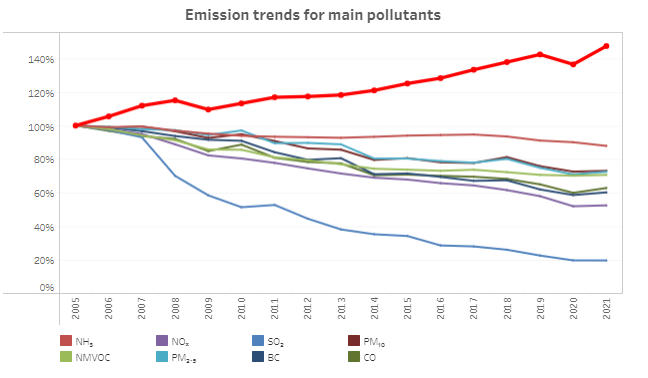
Notes: GDP is gross domestic product at market prices in euros.
Sources: EEA air pollutant emissions data viewer (2023); https://ec.europa.eu/eurostat/web/products-datasets/-/TEC00001 (2023).
Figure 6 shows trends in the total emissions of heavy metals and benzo(a)pyrene (BaP) in the EU Member States, indexed as a percentage of their value in the reference year 2005 and set against EU Member States’ GDP as a percentage of the 2005 value. Emissions of nickel (Ni) and arsenic (As) fell by 63% and 60%, respectively, while mercury (Hg), lead (Pb) and cadmium (Cd) emissions fell by 47%, 42% and 37%, respectively. Emissions of BaP fell by only 16%.
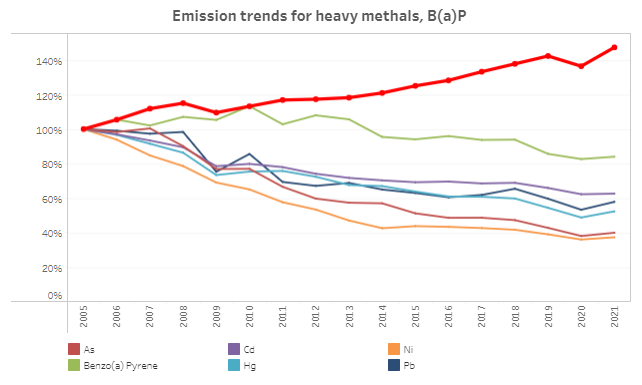
Note: GDP is gross domestic product at market prices in euros.
Sources: EEA air pollutant emissions data viewer (2023); https://ec.europa.eu/eurostat/web/products-datasets/-/TEC00001 (2023).
During the period 2005-2021, emissions showed a significant absolute decoupling from economic activity. Absolute decoupling occurs when an environmental impact variable, such as air pollutant emissions, remains stable or decreases while GDP increases, leading to lower emissions of main air pollutants for each unit of GDP produced annually. Both Figures 5 and 6 show that EU Member States’ air pollutant emissions declined between 2005 and 2021, while EU Member States’ GDP increased by 47%. The greatest decoupling is seen for SO2, followed by NOx, BC, CO and certain metals (Ni, As and Hg).
The decoupling of emissions from economic activity may be the result of a combination of factors, such as increased regulation and policy implementation, fuel switching, technological improvements, and improvements in energy or process efficiencies.
Notes
[1] The data presented in this briefing represent the 2021 emissions as reported by Member States in 2023 and do not include corrections made during the European Commission 2023 inventory review. These corrections are highly unlikely to have a significant impact on the aggregated EU emission levels, but in some cases, they can alter national emissions levels and subsequently performance against an emission reduction commitment.
[2] The data presented here do not include corrections made during the European Commission 2023 inventory review, which may affect national emission levels.
[3] Croatia has to date not reported its air pollutant emissions inventory in 2023.
[4] Secondary PM are formed by chemical reactions of gaseous emissions in the atmosphere.
[5] Primary PM refers to solid or liquid particles directly emitted into the air.
References
EEA, 2023, Europe’s air quality status 2023, EEA Briefing (https://www.eea.europa.eu/publications/europes-air-quality-status-2023).
EC, 2022, Zero pollution action plan https://environment.ec.europa.eu/strategy/zero-pollution-action-plan_en
EC, 2022, Report from the Commission ‘Third clean air outlook’ - https://environment.ec.europa.eu/publications/third-clean-air-outlook_en
EC, 2022, ‘Clean air programme for Europe’ (https://environment.ec.europa.eu/topics/air_en)
EC, 2021a, Communication from the Commission ‘Pathway to a healthy planet for all. EU action plan: Towards zero pollution for air, water and soil’ (COM(2021) 400 final).
EU, 2021, Regulation (EU) 2021/1119 establishing the framework for achieving climate neutrality and amending Regulations (EC) No 401/2009 and (EU) 2018/1999 (‘European Climate Law’) (OJ L 243, 9.7.2021, p. 1-17).
EU, 2016, Directive (EU) 2016/2284 of the European Parliament and of the Council of 14 December 2016 on the reduction of national emissions of certain atmospheric pollutants.
Identifiers
Briefing no. 15/2023
Title: Air pollution in Europe: 2023 reporting status under the National Emission reduction Commitments Directive
EN HTML: TH-AM-23-019-EN-Q - ISBN: 978-92-9480-586-7 - ISSN: 2467-3196 - doi: 10.2800/149724
EN PDF: TH-AM-23-019-EN-N - ISBN: 978-92-9480-585-0 - ISSN: 2467-3196 - doi: 10.2800/339055
Document Actions
Share with others